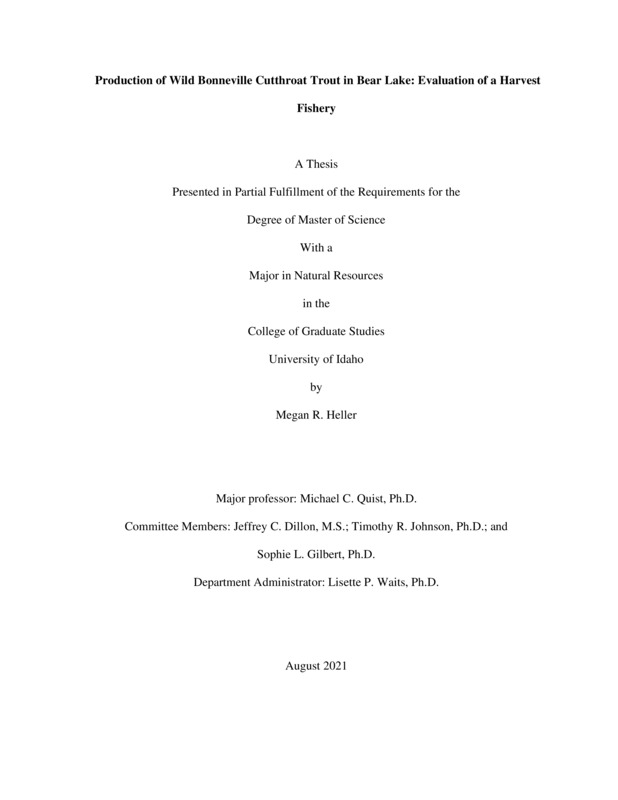Production of Wild Bonneville Cutthroat Trout in Bear Lake: Evaluation of a Harvest Fishery
Heller, Megan Rae. (2021-08). Production of Wild Bonneville Cutthroat Trout in Bear Lake: Evaluation of a Harvest Fishery. Theses and Dissertations Collection, University of Idaho Library Digital Collections. https://www.lib.uidaho.edu/digital/etd/items/heller_idaho_0089n_12156.html
- Title:
- Production of Wild Bonneville Cutthroat Trout in Bear Lake: Evaluation of a Harvest Fishery
- Author:
- Heller, Megan Rae
- Date:
- 2021-08
- Keywords:
- Cutthroat Trout Fish Fish biology Fish ecology Fish management Fisheries
- Program:
- Natural Resources
- Subject Category:
- Natural resource management; Biology; Ecology
- Abstract:
-
Bonneville Cutthroat Trout (BCT) Oncorhynchus clarkii utah is one of fourteen subspecies of Cutthroat Trout Oncorhynchus clarkii and is a species of high ecological and social importance. Bonneville Cutthroat Trout is a species of conservation concern in the states of Idaho and Utah. Bonneville Cutthroat Trout was historically widespread in lentic and lotic systems in the Bonneville basin of Idaho, Nevada, Wyoming, and Utah. During the 1900s, European settlement began in the Bonneville basin and BCT were overexploited in many systems (Behnke and Zarn 1976; Behnke 1992; Lentsch et al. 2000). Additionally, anthropogenic disturbances resulted in an overall loss of suitable habitat for BCT (Lentsch et al. 2000; Teuscher and Capurso 2007; Williams et al. 2009). Overexploitation and loss of habitat for BCT was particularly evident in Bear Lake and its tributaries. Bear Lake is a large, natural, oligotrophic lake located in southeastern Idaho and northern Utah. Four endemic fishes occur in Bear Lake and BCT is the only trout species native to the system. Bonneville Cutthroat Trout in Bear Lake is the only population to follow an adfluvial life history strategy in Idaho (Wurtsbaugh and Hawkins 1990; Behnke 1992; Teuscher and Capurso 2007). Three main spawning tributaries flow into the lake: St. Charles and Fish Haven creeks in Idaho, and Swan Creek in Utah. Nonnative fishes were introduced into the Bear Lake system in the mid 1900s (i.e., Lake Trout Salvelinus namaycush, Brook Trout S. fontinalis, Rainbow Trout Oncorhynchus mykiss) and have likely contributed to the decline in abundance and distribution of BCT. The population of BCT in Bear Lake was considered extirpated by the 1950s (Kershner 1995; Lentsch et al. 2000). In response to the population decline, Utah Division of Wildlife Resources (UDWR) began stocking hatchery BCT in 1973. Additionally, harvest of wild BCT was closed in 1998 and current regulations allow for the daily harvest of two hatchery fish. In the last decade, efforts to improve the population of wild BCT focused on habitat restoration for adfluvial fish in tributaries to Bear Lake. Habitat restoration projects have been largely successful and the proportion of wild BCT in Bear Lake has increased from 5% in 2002 to 70% in 2017. In recent years, a change in harvest regulations to allow for the harvest of wild BCT has been proposed. However, gaining a more comprehensive understanding of the population dynamics and ecology of BCT in Bear Lake and its tributaries is necessary before changes are made to the management of the fishery. Additionally, this research will provide insight on continued habitat restoration efforts and conservation actions. The objectives of my research were to: (1) evaluate ecology and early life history characteristics of BCT in St. Charles, Fish Haven, and Swan creeks; and (2) describe the population dynamics of wild and hatchery BCT in Bear Lake, and evaluate different management options.
- Description:
- masters, M.S., Natural Resources -- University of Idaho - College of Graduate Studies, 2021-08
- Major Professor:
- Quist, Michael C
- Committee:
- Gilbert, Sophie L; Dillon, Jeffrey C; Johnson, Timothy R
- Defense Date:
- 2021-08
- Identifier:
- Heller_idaho_0089N_12156
- Type:
- Text
- Format Original:
- Format:
- application/pdf
- Rights:
- In Copyright - Educational Use Permitted. For more information, please contact University of Idaho Library Special Collections and Archives Department at libspec@uidaho.edu.
- Standardized Rights:
- http://rightsstatements.org/vocab/InC-EDU/1.0/

